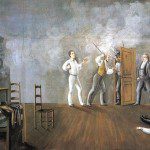Despite the fact that social scientists have yet to discover a single human society that is devoid of what we modern folk usually refer to as religion, it remains a highly contested category. Or, perhaps better, because of the ubiquity of religion, it’s a perspicuously polyvalent term that includes a massive variety of diverse expressions, and is thus notoriously difficult to pin down with precision. Still, however else one might understand the meaning and significance of religious ways of being in the world, one of the most prominent features shared by most traditions is a deep and abiding commitment to narrative. Stories, in other words, often play a decisive role in shaping religious discourse. The way in which any particular narrative might influence any particular tradition will, of course, vary widely, and what I want to do here is reflect on the rhetoric surrounding certain narratives that are central to the self-understanding of the LDS Church
The German philosopher Arthur Schopenhauer once said that Christianity has a “peculiar disadvantage, [in] that, unlike other religions, it is not a pure system of doctrine: its chief and essential feature is that it is a history, a series of events, a collection of facts, a statement of the actions and sufferings of individuals: it is this history which constitutes dogma, and belief in it is salvation.” This is an intriguing observation, but it isn’t immediately apparent why one should think that this ‘peculiarity’ is a distinctively Christian one. Nor is it completely obvious why its historical element should be viewed as a disadvantage. Isn’t the identity of numerous traditions intimately intertwined with some sort of foundational narrative? Whether it’s the night journey of Muhammad across the Arabian desert and his ascension into heaven, Moses’ encounter with the divine and the establishment of the covenant with the children of Israel at Mount Sinai, the death, resurrection, and ascension of Jesus, or the Buddha’s attainment of enlightenment while meditating alongside the Bodhi tree, each narrative is crucial to the self-understanding of the community. Insofar as certain origin stories coincide with the truth-claims of a tradition, don’t many have an evental element that is essential?
Perhaps, however, the significance of Schopenhauer’s statement lies in the word “history.” He goes on to acknowledge that even though the lives of founding figures are important in other religions, on his reading of Buddhism and Judaism, their commitment to their origin stories isn’t essential in quite the same way that it is for Christianity. What is central for them is not a set of historical persons and events, but a set of dogmas—i.e., certain foundational doctrines, teachings, or beliefs are what grant vitality to their faith. Clearly this is a debatable point of view, but what he seems to be suggesting is that what makes Christianity a uniquely evental faith is that it absolutely hangs or falls on certain historical happenings—i.e., something actually happened to actual persons at an actual time in an actual place. Christianity, in other words, is committed to certain objectively real or historical events. In telling the tale of Jesus’ death on the cross, burial in a tomb, and resurrection on the third day, one is not merely a telling a story that has the capacity to inspire someone. Rather, it is to declare the narrative of all narratives, for it is to proclaim a sacrosanct series of events that really took place within the human condition, and are decisive for the salvation of the human condition. Simply put, the salvation of humanity is at stake in the history that constitutes Christianity.
There are obviously a wide variety of views held by Christians thinkers on the question of the salvific character of the resurrection, but Schopenhauer’s suggestion points to what has been a relatively common position. Terryl Givens captures the notion well when he describes the resurrection as the “scandal of Christianity.” He calls it a scandal for at least two reasons. First, it runs directly counter to the way that modern human beings understand the world to work. In this strong literal-historical sense, Jesus’ dead corpse was not only revivified, but was somehow transformed into a glorified immortal body. Can that really happen to a dead body? True enough, the reality of the resurrection seems to be vitally important to most of the New Testament writers, and indeed most Christians, but has anyone reading these words ever encountered such a body? Or, to paraphrase the great twentieth-century Protestant theologian Rudolf Bultmann, can someone who utilizes modern forms of transportation, takes advantage of modern medicine, enjoys the latest advances in modern technology, and understands basic aspects of modern physics; can such a person coherently claim that the atoms of dead bodies can somehow be refashioned into immortal bodies?[1] Indeed, as a twenty-first century citizen of planet earth, what would it even mean to speak of such bodies? For Bultmann, as with many other liberal Protestant theologians, some sort of demythologization is thus necessary—that is, the mythical elements of the ancient worldview must be reinterpreted and reimagined in light of modern scientific understandings.
The second reason that Givens calls the resurrection a scandal is that it’s inseparable from the heart and soul of Christianity. In other words, it’s impossible to pry apart the literal-historical claims regarding the empty tomb from the community and still expect the tradition to survive. To paraphrase Paul, “If Christ has not been literally, physically, and historically raised, then our proclamation has been in vain and your faith has been in vain.”[2] From this point of view, to demythologize the resurrection would be to jettison Christianity’s most essential, precisely because salvific, claim. Although Joseph Smith lived a century before Bultmann, it’s highly unlikely that he would have much interest in or sympathy for the liberal thinkers of his own day—e.g., Schleiermacher. As Smith once stated, “The fundamental principles of our religion are the testimony of the Apostles and Prophets, concerning Jesus Christ, that He died, was buried, and rose again the third day, and ascended into heaven; and all other things which pertain to our religion are only appendages to it.”[3] Christianity’s central claim is thus equally pivotal for Mormonism.
However, Mormonism doesn’t stop with the literal-historical claim of traditional Christianity. It adds what one might call a kind of hyper-literalistic layer with its additional affirmation that because of the resurrection of Jesus every human being will be resurrected. That particular claim isn’t entirely unique to Mormonism, but what is unique is the further metaphysical assertion that no matter who or when or where, somehow every single particle of every human body will be reconstituted as once was, or restored to a state of perfection if it was somehow deficient, and clothed with immortality and (some degree of) eternal glory. Or, as the Doctrine and Covenants puts it, “For notwithstanding they die, they also shall arise again, a spiritual body. They who are of a celestial spirit shall receive the same body which was a natural body; even ye shall receive your bodies, and your glory shall be that glory by which your bodies are quickened.”[4] Given the way that atoms and molecules and cells work, any talk of the “same body” probably doesn’t make much sense, but whether it’s the same body which was the natural body, or some other body of matter that is the body that will somehow be transformed into an immortal body, Mormonism ups the ante of the scandal with such hyper-literal claims.
The main point of Givens’ observation, however, is not about Christianity, but the kind of revelation that Joseph Smith claimed to receive, for it represents a similarly scandalous view.
What I mean by that is that on the face of it, [it is] an affront to sophisticated notions of how the universe works. God doesn’t deliver gold plates to farm boys. It’s a cause of embarrassment to many intellectuals in the church to continue to insist that Joseph had literal gold plates given to him by a real angel that he translates through the Urim and Thummim [seer stones].
But I also mean that it’s a scandal in the sense that it is inseparable from the heart and soul of Mormonism, that one could no sooner divorce the historical claims of the Book of Mormon from the church than one could divorce the story of Christ’s resurrection from Christianity and survive with the religion intact.
Or, as Givens succinctly states it elsewhere, the church stands or falls “on the veracity of the official version of its early history.” Notice here that it’s not simply any history that’s at stake, but the specific version that’s been officially sanctioned by the church. Indeed, he goes so far as to say that “LDS doctrine as a whole is rooted inescapably in history; its claims to divine authority and restored truth are entirely dependent on the narratives of LDS origins.”[5] Anyone who has read Givens knows that he’s a master wordsmith who chooses his words very carefully, so if this sounds like strong language, it’s meant to be, because he wants to forcefully capture the sentiment that has absolutely dominated the LDS self-understanding from its earliest days.
He understands as well as anyone alive that leaders, scholars, and lay-members alike have consistently maintained a “belief in Joseph Smith’s literal visitation by God and heavenly angels, verbally communicating and physically transmitting to him ancient records and priesthood keys.” In Smith, traditional notions of ontological distance between the human and the divine are overcome. Furthermore “without verifiable evidence of a continuing conduit linking Joseph’s successors to God—a God who personally directs the continuing work of the restoration—Mormonism would utterly lose its claim to be the unique institutional form of the one true gospel.” The LDS Church has thus thoroughly committed itself to a literal reading of at least three historical narratives—the narrative of Jesus’ death and resurrection, the narrative of Joseph Smith’s restoration, and the narrative the peoples of the Book of Mormon. These narratives must be true insofar as they really happened in the ways described in their official tellings or its faith is vain. As such, anyone who attempts to challenge orthodox accounts of the church’s past are viewed with extreme suspicion, because they are seen as undermining the beating heart of the faith.[6]
Gordon B. Hinkley, for example, repeatedly maintained throughout his prophetic ministry that everyone “has to face the matter—either the Church is true, or it is a fraud. There is no middle ground. It is the Church and kingdom of God, or it is nothing.”[7] When asked in his interview for the PBS documentary why any notion of a middle ground was unacceptable, he said,
Well, it’s either true or false. If it’s false, we’re engaged in a great fraud. If it’s true, it’s the most important thing in the world. Now, that’s the whole picture. It is either right or wrong, true or false, fraudulent or true. And that’s exactly where we stand, with a conviction in our hearts that it is true: that Joseph went into the [Sacred] Grove; that he saw the Father and the Son; that he talked with them; that Moroni came; that the Book of Mormon was translated from the plates; that the priesthood was restored by those who held it anciently. That’s our claim. That’s where we stand, and that’s where we fall, if we fall. But we don’t. We just stand secure in that faith.
The entire edifice of the LDS Church thus continues to stand or crumbles to the earth based on the historical veracity of its official origin stories.
Like a line of logical dominos, the rationale often runs as follows: if the Book of Mormon is a true record of an ancient people, then Joseph Smith is a prophet; and, if Joseph Smith is a prophet, then he must have received the divine authority of the priesthood; and, if he received the priesthood, then all of his successors have held that same authority; and, if all subsequent Presidents of the church have held that same authority, then the LDS Church is God’s kingdom on earth. The same rationale often begins with the first vision, so that if either one of the central narratives is true, then it necessarily follows that everything else is true. More than history as theology, this is hyper-literal history as the foundation of an entire religion.
This is why a contemporary Apostle, like Jeffrey R. Holland, wouldn’t hesitate to affirm that this is not merely an epistemic matter but an existential necessity:
I am suggesting that we make exactly that same kind of do-or-die, bold assertion about the restoration of the gospel of Jesus Christ and the divine origins of the Book of Mormon. We have to. Reason and rightness require it. . . . Accept Joseph Smith as a prophet and the book as the miraculously revealed and revered word of the Lord it is or else consign both man and book to Hades for the devastating deception of it all, but let’s not have any bizarre middle ground about the wonderful contours of a young boy’s imagination or his remarkable facility for turning a literary phrase. That is just an inconceivable and, finally, unacceptable position to take—morally, literarily, historically, or theologically.[8]
The force of the dichotomy could not be clearer: either the Book of Mormon represents the reality of divine inspiration and the actuality of an ancient people, or the church that proclaims its message is nothing more than a ‘devastating deception.’
Nineteenth-century Apostle Orson Pratt expresses a similar sentiment in his “Divine Authenticity of the Book of Mormon”:
The Book of Mormon claims to be a divinely inspired record, written by a succession of prophets who inhabited ancient America. . . . This book must be either true or false. If true, it is one of the most important messages ever sent from God to man, affecting both the temporal and eternal interests of every people under heaven . . . If false, it is one of the most cunning, wicked, bold, deep-laid impositions ever palmed upon the world, calculated to deceive and ruin millions who will sincerely receive it as the word of God. . . . If true, no one can possibly be saved and reject it; if false, no one can possibly be saved and receive it.
Throughout its history, then, LDS leaders have employed this sort of dichotomous rhetoric to establish the authenticity of its witness. Indeed, it appears as though they see no other way of establishing their credibility. Unsurprisingly, its detractors are equally committed to the bifurcation. Hence, although the polemical voices on either side stand in polarized places, there is one thing about which they are in complete agreement: either true or false, either good or evil, either authentic or deceptive, either divine or satanic, either ancient or modern, either-or, either-or, either-or. There is no middle ground.
But is this binary opposition really the only viable option? Is this discourse of dichotomy truly the only possibility for making sense of these highly complex issues? Does the domino rationale actually work when carefully considered? Is it logically possible, for example, that Smith could have experienced a genuine theophany some time during his middle teenage years, and that at certain points during his prophetic ministry he not only exemplified a Christ-like life but also engaged in morally repugnant behavior? Is it logically possible that Smith transmitted the Book of Mormon by the gift and power of God, but that there were also times when he led his community in directions that were entirely devoid of a divine influence? Is it logically possible that the transmission of the Book of Mormon constitutes a complex combination of both human imagination and divine inspiration? Is it logically possible that the Book of Mormon includes both historical and non-historical people, places, and events? Is it logically possible that divine authority was given to Joseph Smith, but that that authority does not reside within the LDS Church? Is it logically possible that the movement Smith founded, at every stage of its history, and in every one of its branches, contains elements of goodness and truth as well as ugliness and falsity?
Put differently, even if Joseph Smith had a profound encounter with the Divine, does it necessarily entail that the Book of Mormon was produced under divine direction? It may very well be the case that both propositions are true, but does one necessarily follow from the other? Even if the Book of Mormon contains profound truths that are worth committing one’s life to, does that necessarily entail that its entire narrative from beginning to end must be historical? Furthermore, does its divine authenticity logically demand that one also accept that Smith received the divine authority of the priesthood; or, does its historical veracity necessarily lead to the conclusion that that authority is present within the contemporary LDS Church; or, does its truthfulness necessarily entail that the LDS Church is everything it claims to be? All of those things may very well be the case individually, but does the truthfulness of one necessarily follow from the truthfulness of any other? The reality of branches of Mormonism other than the Salt Lake-based church would seem to provide sufficient justification to say that the answer to this line of inquiry is decidedly, “No.” The fact that there are thousands of believers throughout the world who claim that Joseph Smith is a prophet and that the Book of Mormon is scriptural but may not be historical, and also maintain that The Church of Jesus Christ of Latter-day Saints is not the kingdom of God on earth, is just one reason why one might want to reconsider the validity of the discourse of dichotomy. Perhaps it represents only two extremes among many viable options.











